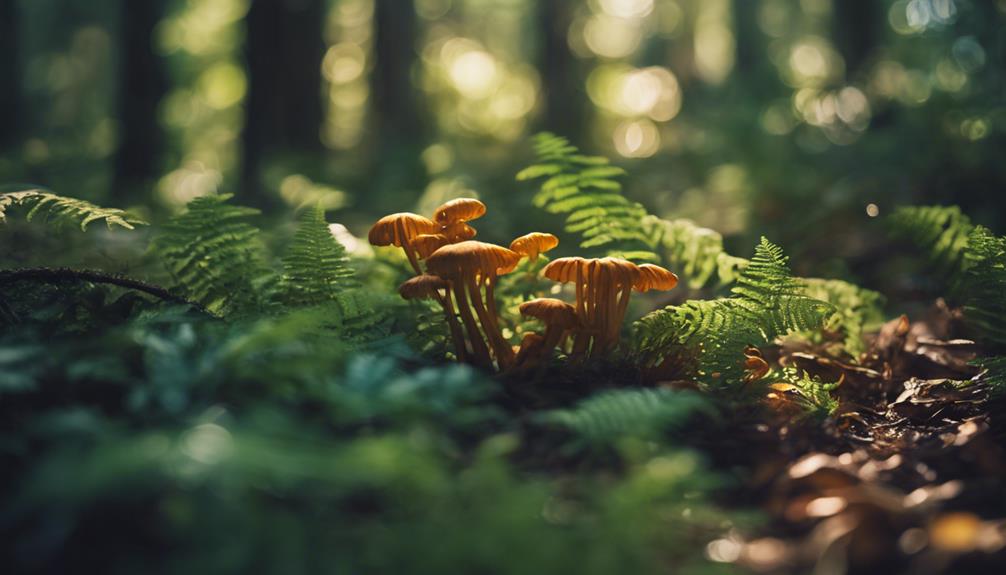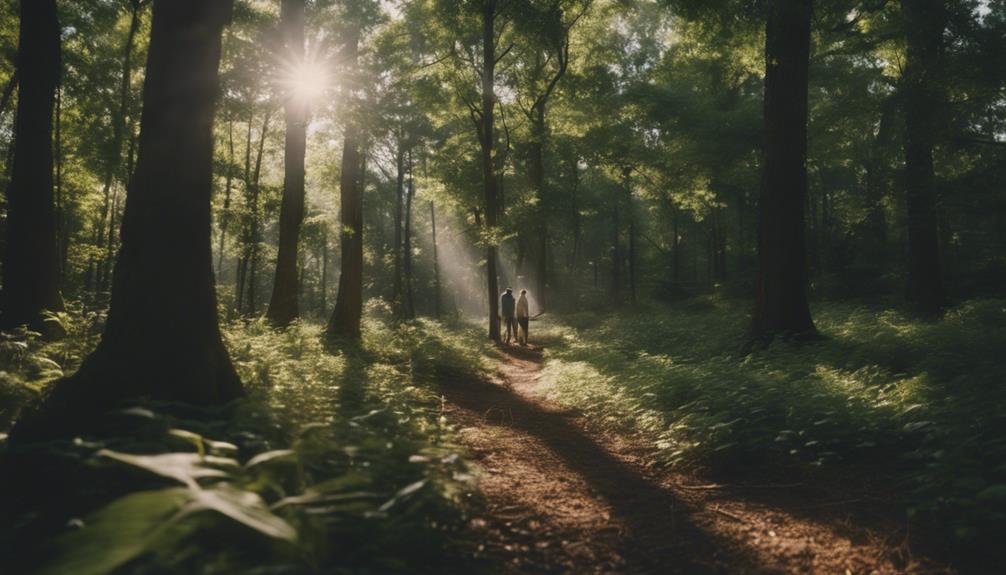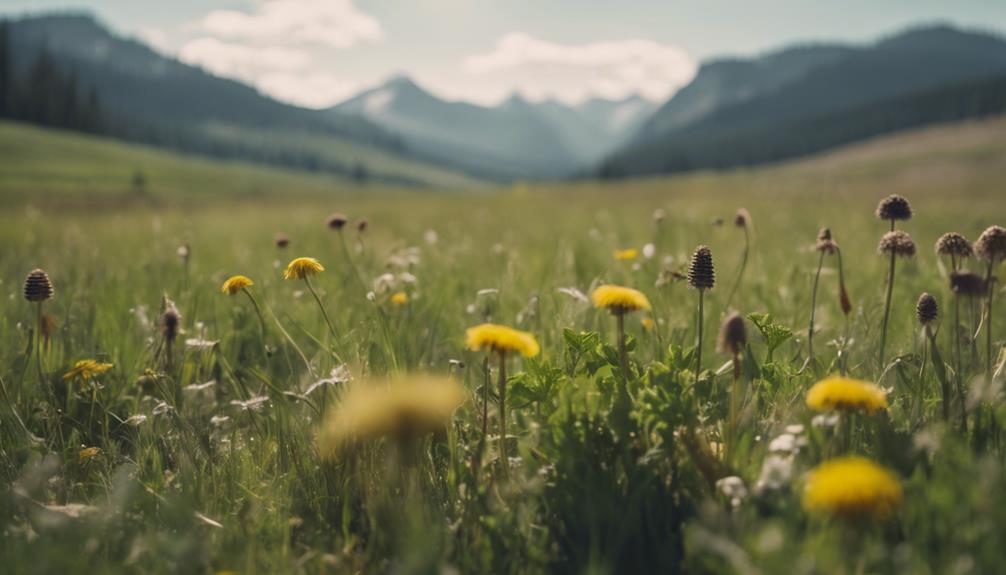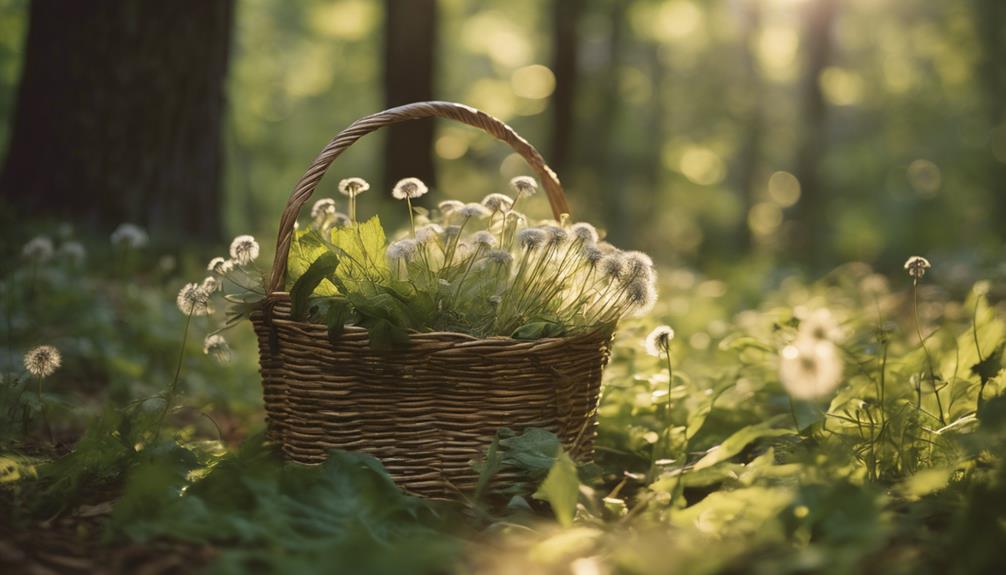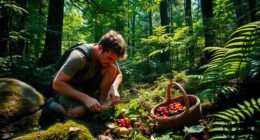As you explore Florida's diverse landscape, you'll uncover a paradise of wild edibles waiting to be discovered and devoured. From flax lily berries to Spiderwort flowers, each plant offers unique flavors and textures. Local experts and organizations like the Native Plant Society can guide you in identifying and harvesting wild edibles. With proper knowledge, you can forage for fresh fungi, like Lion's Mane, and discover edible treasures in the Everglades, like saw palmetto berries and Coontie roots. As you continue on this culinary adventure, you'll uncover the secrets of Florida's wild and fresh flavors, and the possibilities will be endless.
Key Takeaways
- Florida's diverse landscape offers a variety of wild edibles, including flax lily berries, Spiderwort flowers, and saw palmetto berries.
- Local experts and organizations, like the Native Plant Society, provide guidance on identifying and harvesting wild edibles.
- Foraging in Florida's subtropical climate and diverse geography builds confidence in identifying edible plants with a wide range of options.
- Seasonal plant study is crucial for deep knowledge, as plant characteristics and edibility vary across seasons.
- Proper identification is vital to avoid toxic species, especially when foraging for wild mushrooms, and expert guidance is recommended.
Discovering Florida's Hidden Edibles
As you explore Florida's diverse landscape, you'll reveal a treasure trove of hidden edibles, from flax lily berries to Spiderwort flowers, leaves, and stems, waiting to be discovered and savored.
Florida's wild edible plants are a forager's paradise, offering a wide range of flavors and textures to explore. With guidance from local experts and organizations like the Native Plant Society, you'll gain confidence in identifying and harvesting these wild edibles. Whether you’re interested in nutritious greens, medicinal herbs, or flavorful berries, there’s something for every palate in Florida’s natural landscape. Foraging in Wyoming’s wilds, by contrast, offers a different yet equally rewarding experience with high-altitude plants and unique ecosystems to discover. Both regions offer incredible opportunities for reconnecting with nature and cultivating sustainable, seasonal diets.
As you investigate further into Florida's flora, you'll uncover the nuances of each plant, from the sweet taste of flax lily berries to the subtle bitterness of Spiderwort leaves.
By studying these plants season after season, you'll develop a deep understanding of their variations and habitats. With each new discovery, you'll reveal the secrets of Florida's wild edible plants, and your culinary adventures will take on a whole new dimension.
Wild Delights of the Sunshine State

You'll stumble upon a fascinating array of wild delights in the Sunshine State, where the subtropical climate and diverse geography have given rise to a vibrant tapestry of flavors, textures, and aromas.
As you venture into Florida's wilderness, you'll discover a plethora of wild edibles waiting to be explored. From Flax lily berries to Spiderwort flowers, the variety of wild food is vast and exciting.
Foraging in Florida is an ideal way to build confidence in identifying edible plants, thanks to the wide range of options available. To guarantee accurate identification, consider consulting local experts or the Native Plant Society.
Studying plants season after season is essential for developing a deep knowledge of edible flora in Florida. Remember, accurate identification is crucial – Jamaica caper flower buds, for instance, aren't listed as edible in Florida.
Foraging for Fresh Fungi

Venture into Florida's forests and you'll uncover a fascinating domain of fresh fungi, where unique varieties like Lion's Mane await discovery. As you forage for wild, edible mushrooms, remember that proper identification is vital. You'll need to distinguish between safe, edible species and their toxic look-alikes.
The Jack-O'-Lantern mushroom, for instance, can mimic the appearance of a poisonous species, making it important to exercise caution. Florida's diverse ecosystems offer a wide range of wild mushrooms for you to discover, but it's critical to approach foraging with knowledge and respect.
Don't rely on guesswork or assumptions – take the time to learn about the different species, their habitats, and distinguishing features. With the right skills and mindset, you'll be able to uncover the secrets of Florida's fungal kingdom, enjoying the thrill of the hunt and the satisfaction of savoring fresh, wild, and edible fungi.
Edible Plants of the Everglades

As you venture into the Everglades, you'll discover a treasure trove of edible plants waiting to be discovered.
From the antioxidant-rich saw palmetto berries to the Coontie roots that can be used to make flour, the Everglades is a forager's paradise.
Get ready to uncover the swampy delicacies and wild herbs with medicinal properties that'll take your foraging skills to the next level.
Swampy Delicacies Abound Here
Deep in the Everglades, the swampy waters and tangled vegetation conceal a treasure trove of edible delights, waiting to be uncovered by intrepid foragers. As you venture into this unique ecosystem, you'll discover a variety of common plants that are not only edible but also packed with nutrients. Dollar weed, for instance, is a common plant found in North America, including the Everglades, and is rich in vitamins and minerals.
| Edible Plant | Description |
|---|---|
| Saw Palmetto Berries | Rich in nutrients, used for medicinal purposes |
| Cattail Shoots | Edible and can be cooked or eaten raw |
| Wild Grapes | Sweet and juicy, perfect for snacking |
As you explore the Everglades, you'll find that learning to identify and harvest these wild edibles enhances the foraging experience. From elderberries to beautyberries, the Everglades offers a diverse range of edible plants waiting to be discovered. So, grab your basket and get ready to forage for these swampy delicacies!
Wild Herbs for Medicine
Beyond the swampy delicacies, you'll find a wealth of wild herbs in the Everglades, packed with medicinal properties that have been harnessed by indigenous communities for centuries.
As you venture into the wild, you'll discover that these herbs offer natural remedies for various ailments. Foraging for wild herbs in the Everglades provides a unique opportunity to connect with nature and traditional healing practices.
You'll find that some of these herbs have been used for centuries to treat everything from fever to skin irritations.
As you explore the wild herbs of the Everglades, you'll uncover new ways to incorporate them into your natural medicine practices. From treating digestive issues to reducing inflammation, the medicinal properties of these herbs are vast and varied.
By foraging for these wild herbs, you'll not only gain access to natural remedies but also develop a deeper appreciation for the natural world and the traditional practices of indigenous communities.
Harvesting Coastal Treasures

You'll find a treasure trove of edible delights along Florida's coastline, where sea grapes, sea purslane, and beach sunflowers thrive. One thing you'll love about coastal foraging is that it's as simple as taking a walk along the beach and discovering these hidden gems. As you stroll, keep an eye out for sea grapes, whose leaves can be used to make dolmas or enjoyed fresh as a salty snack. Sea purslane, rich in vitamins and minerals, adds a burst of freshness to any meal. Beach sunflowers, with their edible leaves and seeds, bring a unique flavor to salads and dishes.
Here's a snapshot of what you can expect to find on your coastal foraging adventure:
| Plant | Edible Parts | Uses |
|---|---|---|
| Sea Grapes | Leaves | Dolmas, Salty Snack |
| Sea Purslane | Leaves, Stems | Fresh Salads, Sauces |
| Beach Sunflowers | Leaves, Seeds | Salads, Dishes |
| Wild Blueberries | Fruits | Snacking, Baking |
| Beach Greens | Leaves | Fresh Salads, Smoothies |
As you explore the coastline, remember that coastal foraging provides a sustainable way to connect with nature and enjoy local, wild foods. Happy foraging!
Berries and Blossoms of Spring

As you venture into Florida's spring landscape, you'll discover a treasure trove of wild berries and blossoms waiting to be uncovered.
You're about to learn the secrets of harvesting these sweet treats, from tips on identifying the ripest berries to exploring the unique flavor profiles of blossoming flowers.
Get ready to uncover the best hotspots for foraging in spring, and elevate your foraging skills in the process.
Wild Berry Harvesting Tips
During Florida's spring season, you're likely to stumble upon ripe wild berries, including blackberries, blueberries, and strawberries, which are ready to be plucked and devoured. As you venture out to forage for these tasty treats, make sure to follow some essential harvesting tips.
| Berry | Color | Harvest Time |
|---|---|---|
| Blackberry | Dark purple | Late spring |
| Blueberry | Powder blue | Early spring |
| Strawberry | Bright red | Early spring |
When foraging for wild berries, make sure to inspect the berries carefully to make certain they're ripe and free of mold or pests. Avoid berries that are unripe, as they may cause stomach issues. Also, be cautious of lookalike berries that may be poisonous, like pokeweed. By being mindful of these tips, you can enjoy a safe and delicious harvest of fresh, wild berries.
Blossoming Flavor Profiles
Spring's vibrant blooms and berries in Florida offer you a kaleidoscope of flavors, from the sweet and subtle to the bold and tangy. As you explore the edible blooms and berries of spring, you'll discover a world of flavors to elevate your culinary creations.
Flax lily berries, for instance, burst with sweetness and subtle hints of flavor. Spiderwort flowers add a delicate taste to dishes, while their vibrant colors add a pop of color to your plates. You might even experiment with Jamaica caper flower buds, which, although not traditionally considered edible, bring a unique floral essence to recipes.
Spring Foraging Hotspots
Your search for Florida's hidden gems begins in its parks, nature reserves, and even urban areas, where wild edible plants thrive in the spring. As you explore these areas, keep an eye out for open fields and wooded areas, where wild blackberries, blueberries, and strawberries are ripe for the picking. You might also stumble upon edible blossoms like Elderflowers, Honeysuckle, and Daylilies in gardens and natural areas.
| Spring Foraging Hotspots | Wild Edibles to Find | Tips for Foraging |
|---|---|---|
| Parks | Wild blackberries, blueberries | Look for open fields and wooded areas |
| Nature Reserves | Elderflowers, Honeysuckle | Inspect gardens and natural areas |
| Urban Areas | Wild strawberries, Daylilies | Explore abandoned lots and green spaces |
| Wooded Areas | Wild blueberries, blackberries | Be mindful of pesticide use |
| Gardens | Edible flowers and herbs | Respect private property and foraging laws |
Summer's Bounty of Wild Herbs

As you venture into Florida's lush summer landscape, you'll discover a treasure trove of wild herbs waiting to be foraged. Summer brings an abundance of fresh flavors to incorporate into your meals, and foraging for wild herbs is a great way to do so.
Here are some of the summer's bounty of wild herbs you can forage:
- Wood Sorrel: With its heart-shaped leaves, wood sorrel offers a lemony taste perfect for summer dishes.
- Caesar Weed: As a member of the mint family, Caesar weed adds an invigorating twist to salads and teas.
- Fresh Flavors: Foraging for wild herbs in the summer allows you to incorporate fresh, local ingredients into your meals.
- Unique Flavors: Wild herbs like wood sorrel and Caesar weed provide unique flavors that will elevate your summer cooking.
Autumn's Abundance of Mushrooms

As you explore Florida's autumn landscape, you'll discover a treasure trove of edible mushrooms waiting to be uncovered. From the forest floor to the trees themselves, autumn's abundance of mushrooms is ripe for the picking – if you know where to look.
In the following sections, we'll uncover the forest floor finds and fungi foraging tips you need to get started on your mushroom foraging journey.
Forest Floor Finds
Having advanced knowledge of mushroom identification is crucial during autumn in Florida when the forest floor transforms into a treasure trove of wild mushrooms, beckoning foragers to uncover the hidden gems. Local mycological societies and experts can provide guidance on identifying and safely consuming wild mushrooms.
Some of the most sought-after species you might find include:
- Chanterelles, prized for their fruity, apricot-like aroma and peach-colored flesh
- Bolete mushrooms, characterized by their distinctive pores and rich, earthy flavor
- Other edible species, each with unique characteristics and flavors
As you explore the forest floor, remember to always prioritize safety and responsible foraging practices. With the right knowledge and precautions, you can add a diverse and flavorful element to your wild food gathering in Florida.
Fungi Foraging Tips
When autumn's warm rains awaken Florida's fungal bounty, you'll find yourself surrounded by an array of species, each with its unique characteristics and flavor profiles.
As you venture into the woods, keep an eye out for mushrooms growing near trees, in damp areas, or on decaying wood – these are prime foraging spots.
But before you start picking, make sure you're absolutely sure about what you're collecting. Consult with local experts to guarantee safe identification of edible mushrooms, as some species can be toxic or even deadly.
Popular edible mushrooms in Florida include chanterelles, oyster mushrooms, and chicken of the woods.
Remember, it's always better to err on the side of caution – if in doubt, don't eat it! With a little knowledge and caution, you can enjoy the rich flavors and textures of Florida's wild mushrooms.
Happy foraging!
Winter's Wild and Forgotten Foods

You'll be surprised by the variety of wild edible plants that winter in Florida has to offer, including chickweed, dandelion, and wild onions. As you venture out into the wild, you'll discover a treasure trove of nutritious and tasty finds.
Winter is an excellent time to forage for wild garlic, winter cress, and other forgotten foods.
Some of the winter wonders you can uncover include:
- Chickweed, a common winter green, packed with nutrients and vitamins
- Dandelions, rich in vitamins and perfect for adding a bitter flavor to your dishes
- Wild onions, a flavorful addition to any meal
- Wild garlic, a tasty alternative to store-bought garlic
As you explore Florida's wilderness during the colder months, keep an eye out for these hidden gems. With a little knowledge and practice, you can enjoy the freshest, most flavorful ingredients nature has to offer.
Cooking With Wild Florida Flavors

As you bring your foraged treasures back to the kitchen, start experimenting with innovative recipes that showcase the unique flavors and textures of Florida's wild ingredients.
You'll be surprised at how cooking with wild Florida flavors can reveal the full potential of your dishes and add a touch of freshness and nutrition.
For instance, incorporate flax lily berries into a sweet and tangy jam or use Spiderwort flowers to create a beautiful and edible garnish.
By utilizing wild Florida plants in your recipes, you'll not only enhance the local and seasonal aspect of your meals but also discover new flavors and textures that will set your culinary creations apart.
Don't be afraid to get creative and experiment with different combinations of wild ingredients to create truly unique dishes.
With Florida's diverse flora at your fingertips, the possibilities are endless, and your taste buds will thank you.
Frequently Asked Questions
Is Foraging Legal in Florida?
You're wondering if foraging is legal in Florida. Well, yes, it is, as long as you're not on private property without permission and you're not harvesting protected or endangered plants.
What Is the Number One Rule of Foraging?
As you venture into the wild, remember that the number one rule of foraging is to positively identify plants before consumption, lest you risk ingesting toxic species, and always prioritize caution over curiosity.
What Not to Eat When Foraging?
When foraging, you should avoid eating plants with shiny leaves, milky sap, strong odors, thorns, or bitter tastes, as they're likely toxic, and steer clear of mushrooms unless you're an expert at identifying them safely.
What Food Grows Wild in Florida?
You're curious about what food grows wild in Florida! You'll find an array of wild edibles, including flax lily berries and Spiderwort flowers, leaves, and stems, but be sure to identify them correctly to avoid mistakes.
Conclusion
As you begin your foraging adventure, remember to 'seize the day' and respect the land. Florida's wild edibles are a treasure trove waiting to be discovered.
From the Everglades to the coast, each season brings a new bounty of flavors and ingredients. So, grab your basket and get foraging!
With a little knowledge and a lot of curiosity, you'll be dining like a king (or queen) in no time. Bon appétit, and happy foraging!

